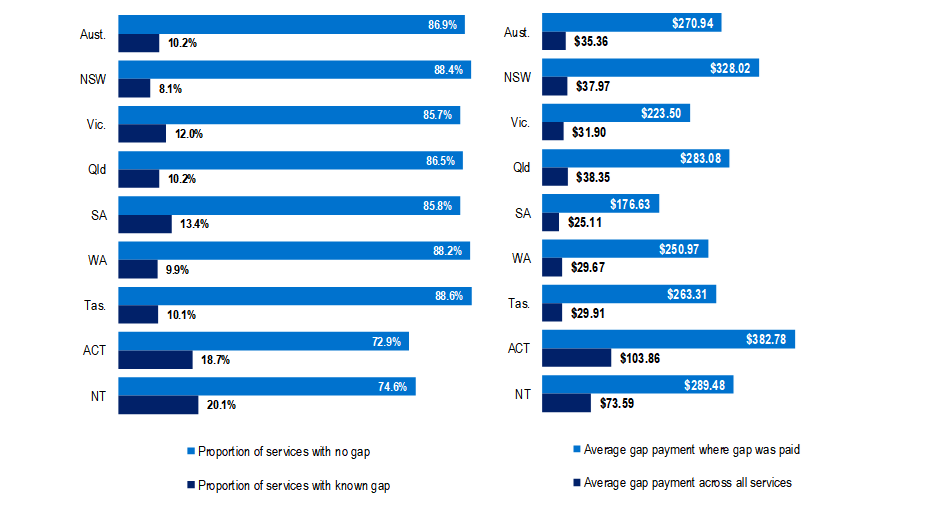Quarterly private health insurance membership and benefits summary - March 2025
Key metrics
Hospital treatment membership

General Treatment membership

Hospital treatment episodes

General treatment services (ancillary)

Benefits

Out- of -pocket per episode/service

Membership and coverage
Hospital Treatment
At 31 March 2025, 12,482,109 people, or 45.3% of the population, were covered by hospital treatment cover. There was a slight increase compared to December 2024.
There was an increase in coverage of 81,309 insured people in the March 2025 quarter compared to December 2024. Family policies increased by 10,887 and single policies by 19,531 during the quarter.
The largest increase in coverage during the quarter was 9,701 for people aged between 40 and 44. The largest net increase (taking into account movement between age groups) was for the 0-4 with an increase of 28,638 people.
Net quarterly change in insured persons
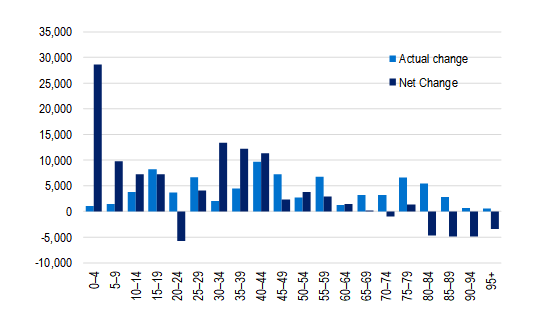
Lifetime health cover
The majority of adults with hospital cover (87.7%) have a certified age of entry of 30, with no LHC loading.
At the end of the 31 March 2025 quarter, there were 1,102,216 people with a certified age of entry of more than 30 and subject to a Lifetime Health Cover loading; a net increase in people paying a penalty over the preceding 12 months of 83,145. There was a net increase in people with a certified age of entry of 30 (with no penalty) over the year of 120,268. Over the year, 102,976 people had their loading removed after paying a loading for ten years.
Number of persons insured by age

Hospital treatment tables
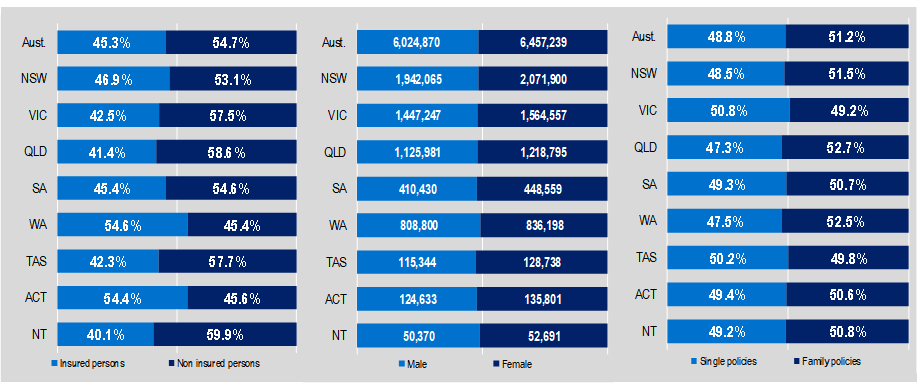
General Treatment
At 31 March 2025, 15,158,171 people or 55.1% of the population had some form of general treatment cover. There was an increase of 97,380 people when compared to the December quarter. There was an increase of General Treatment policies of 49,672 for March 2025 which was mainly driven by Single Policies which increased by 27,577. For the 12 months to 31 March 2025, the number of insured persons with general treatment cover has increased by 350,561.
Net quarterly change in insured persons (ancillary)
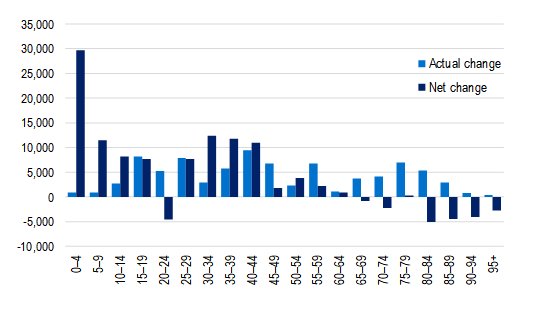
The general treatment (ancillary) by age charts and data in this report show data for those people that have general treatment policies covering ancillary services, regardless of other treatment included in the product. This excludes those general treatment policies that do not cover ancillary treatment.
There was an increase of 84,891 people with general treatment (ancillary) coverage in the March 2025 quarter. The largest net increase in coverage, after accounting for movements across age groups, was 29,725 for people in the 0 to 4 age group.
Number of persons insured by age (ancillary)
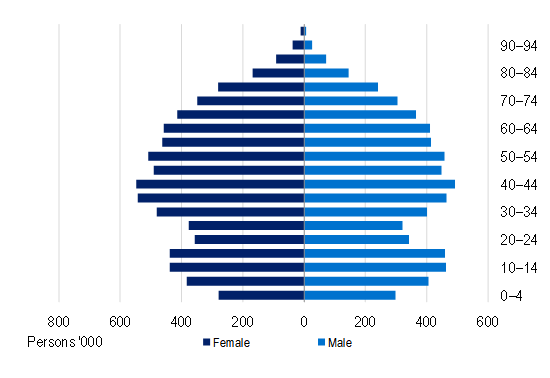
General treatment tables (ancillary)
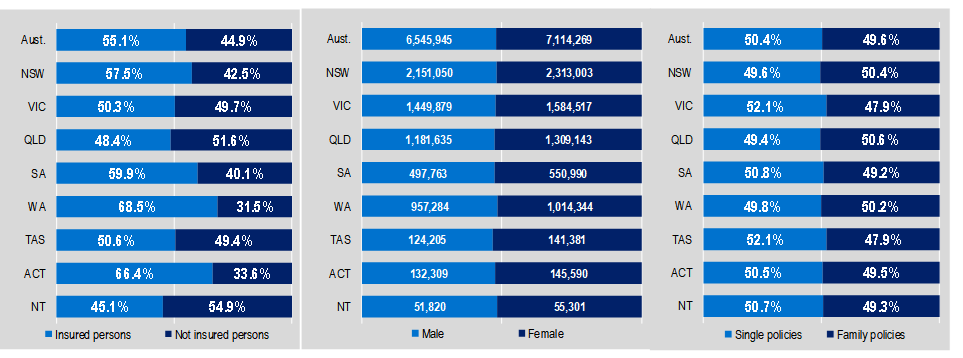
Benefits Paid
Hospital treatment
Benefits per episode/service
| Hospital treatment | March 2025 | Change from December 2024 |
|---|---|---|
| Acute | $2,692 | 0.6% |
| Medical | $68 | -0.8% |
| Medical devices or human tissue products | $654 | -0.4% |
| Cardiac | $3,172 | 1.3% |
| Hip | $1,612 | 0.6% |
| Knee | $1,666 | 0.3% |
| Total benefits and growth rate |
| |
| Hospital | $4,464,511,739 | -7.0% |
| General | $1,787,029,629 | 2.9% |
During the March 2025 quarter, insurers paid $4,464.51 million in hospital treatment benefits, which was 7% lower compared to the December 2024 quarter. Hospital treatment benefits were comprised of:
- $3,247.56 million for hospital services such as accommodation and nursing
- $658.24 million for medical services
- $558.71 million for medical devices or human tissue items
Hospital treatment benefits paid by age 12 months to 31 March 2025
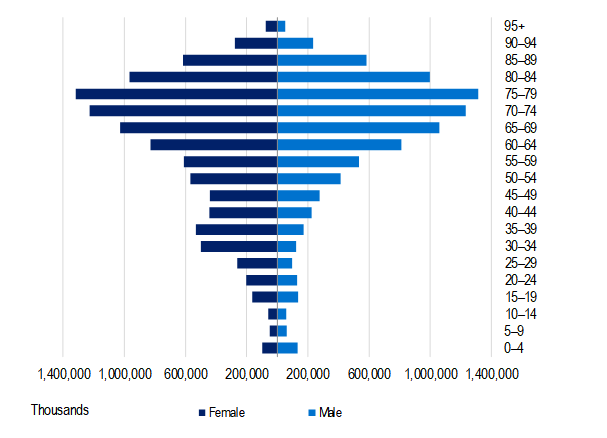
The age group for which most hospital benefits are paid is between 75 and 79 (top chart). Total benefits by age group is affected by the average benefits paid per person (displayed in the second chart) and the number of people in each age group.
Average hospital benefits per person increased from $1,453.20 for the year ending March 2024 to $1,514.73 for the year ending March 2025. The largest amount of benefits per person was spent on hospital accommodation and medical, followed by medical services and then medical devices or human tissue benefits.
Hospital treatment benefits per person covered and percentage of benefits paid by age cohort
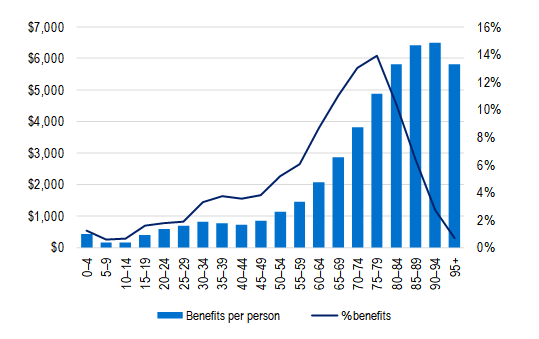
Hospital treatment benefits per person
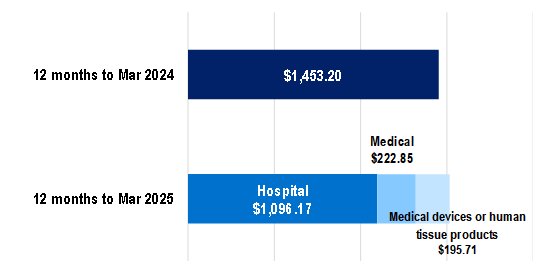
General treatment
Benefits per service
March 2025 | Change from December 2024 | |
|---|---|---|
| Dental | $70 | 4.2% |
| Chiropractic | $36 | 9.3% |
| Physiotherapy | $43 | 7.1% |
| Optical | $86 | 3.1% |
During the March 2025 quarter, insurers paid $1,776.69 million in general treatment (ancillary) benefits. This was a decrease of 3.2% compared to the December 2024 quarter. Ancillary benefits for the March 2025 quarter included the major categories of:
- Dental $955.76 million
- Optical $278.75 million
- Physiotherapy $136.73 million
- Chiropractic $87.21 million.
General treatment benefits paid by age 12 months to 31 March 2025 (ancillary)
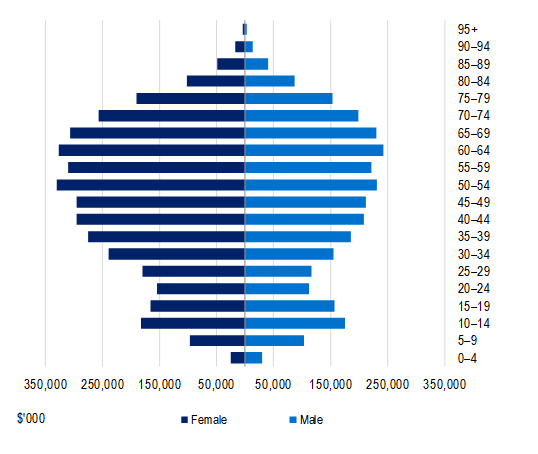
There is a marked difference between the distribution of benefits over age groups between hospital benefits and ancillary benefits. The major difference is the higher claiming rate in older age groups for hospital benefits while benefits per person for ancillary benefits are more evenly spread over the age groups.
General treatment (ancillary) benefits per person during the year to March 2024 were $464.68. decreased to $374.75 for the year to September 2024. The largest component of ancillary benefits is dental, for which $204.69 was paid per insured.
General treatment benefits per person covered and percentage of benefits paid by age cohort (ancillary)
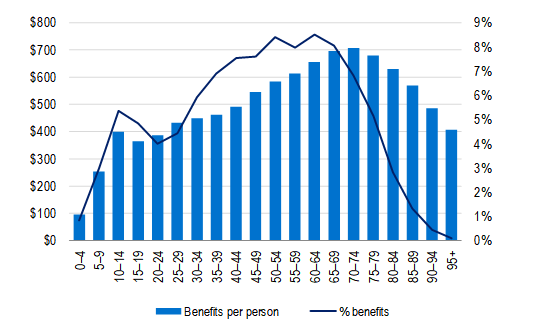
General treatment benefits per person (ancillary)
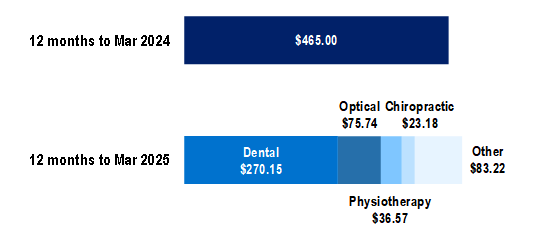
Medical benefits
Total benefits for medical services decrease by 8.7% during the March quarter 2025.
The change in medical benefits paid per service was calculated over a range of medical services and does not mean medical services overall decreased or increased in cost. The average benefits paid reflects the type of medical services utilised during the quarter as well as the volume of services. The medical service for which the greatest amount of benefits was paid was anaesthetics, comprising 25.3% of all medical benefits and totalling $166.21 million.
Medical devices or human tissue benefits
Total benefits paid for medical devices or human tissue products decreased by 10.9% in March 2025 compared to December 2024.
Similar to medical services, the change in benefits paid for medical devices or human tissue products was calculated over a range of medical devices or human tissue products (see chart) and does not mean medical devices or human tissue products overall changed in cost. The change in benefits paid may reflect a change in the type of medical devices or human tissue products utilised, or a change in the overall utilisation of medical devices or human tissue products. The medical devices or human tissue products group for which the greatest amount of benefits were paid was cardiac, comprising 18.1% of all medical devices or human tissue products benefits and totalling $99.94 million.
Medical benefits by Speciality group
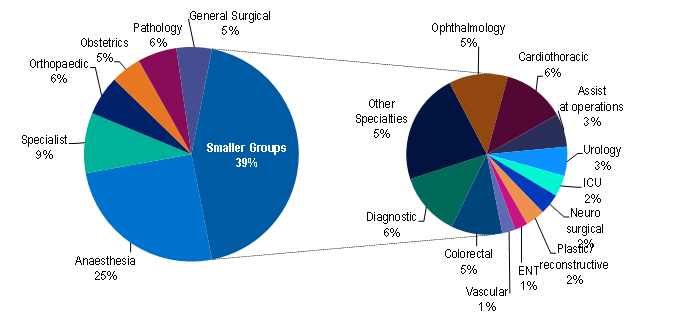
Benefits paid for medical devices or human tissue products

Service utilisation
Episodes/Services by type
March 2025 | Change from December 2024 | |
|---|---|---|
| Hospital Episodes | 1,206,056 | -6.7% |
| Hospital Days | 3,011,824 | -4.8% |
| Medical Services | 9,720,895 | -8.0% |
| Medical devices or human tissue Item | 854,623 | -9.8% |
| Specialist Orthopaedic | 160,698 | -4.5% |
| Ophthalmic | 94,531 | -10.6% |
| Spinal | 46,617 | 9.8% |
| General Treatment | 27,566,619 | -0.2% |
| Dental | 13,585,153 | -2.5% |
| Chiropractic | 2,395,623 | 16.2% |
| Physiotherapy | 3,174,728 | 14.3% |
| Optical | 3,259,296 | -14.9% |
During the March 2025 quarter, insurers paid benefits for 3.0 million days in hospital, arising from 1.2 million hospital episodes of care.
Hospital utilisation is distributed over four categories of hospital—public, private, day only facilities and hospital-substitute. During the March 2025 quarter, hospital episodes were distributed as follows:
- public hospitals 174,724 episodes
- private hospitals 802,625 episodes
- day hospital facilities 167,720 episodes
- hospital substitute 60,987 episodes
For the March 2025 quarter, hospital utilisation (measured in episodes) increased by 6.7% which was mainly driven by hospitals-substitute.
Quarter change | Year change | |
|---|---|---|
| Public hospitals | ↓ -1.8% | ↑ 2.8% |
| Private hospitals | ↓ -8.4% | ↑ 3.8% |
| Day hospital facilities | ↓ -2.3% | ↑ 1.6% |
| Hospital-substitute | ↓ -8.2% | ↑ 4.0% |
Day-only episodes in the four categories of hospital totalled 844,676 with a 7.2% change compared to December 2024.
Hospital treatment services per 1,000 insured persons

General treatment services (ancillary) per 1,000 insured person
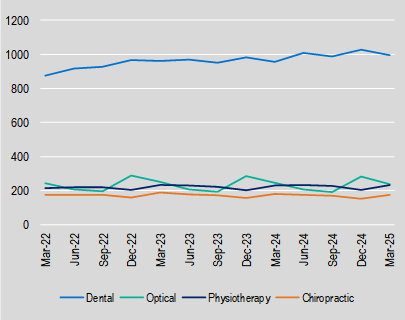
Out-of-pocket payments
Average out-of-pocket per episode/service
March 2025 | Change from Dec 24 | Change from Mar 24 | |
|---|---|---|---|
| Hospital treatment | $470.80 | 7.2% | 10.4% |
| Hospital-substitute treatment | $3.57 | -7.1% | -13.0% |
| General treatment ancillary | $61.64 | 3.6% | 5.1% |
| Medical gap where gap was paid | $270.81 | -2.0% | 6.6% |
The average out-of-pocket (gap) payment for a hospital episode was $470.80 in the March 2025 quarter. This included out-of-pocket payments for medical services, in addition to any excess or co-payment amounts relating to hospital accommodation.
The out-of-pocket payments for hospital episodes increased by 10.4% compared to the same quarter for the previous year.
Out-of-pocket payments for medical services were $270.81 where an out-of-pocket payment was payable. The amount of gap for medical services varies depending on the specialty group. The specialty group with the largest out- of-pocket payment was Orthopaedic with an average gap of $760.43. Gap incurred for the various medical services is displayed in the first chart. Medical gap also varies by state and territory and these differences are shown in the bottom chart.
Medical benefits and out-of-pocket by specialty group
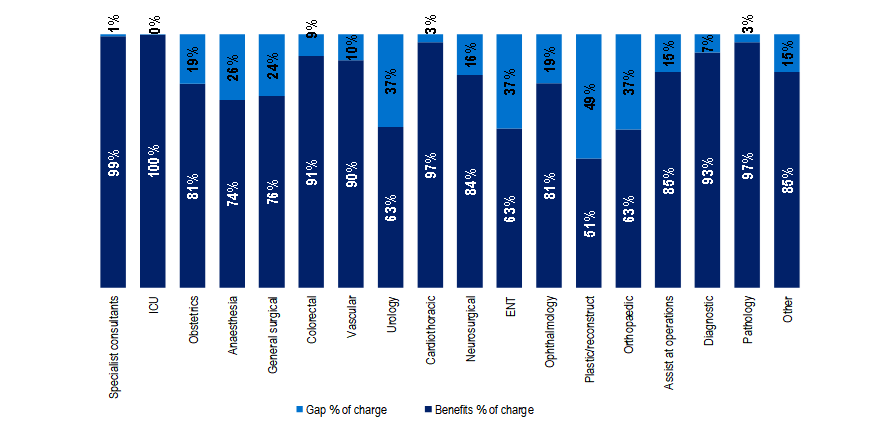
Proportion of services and average out-of-pocket payments
